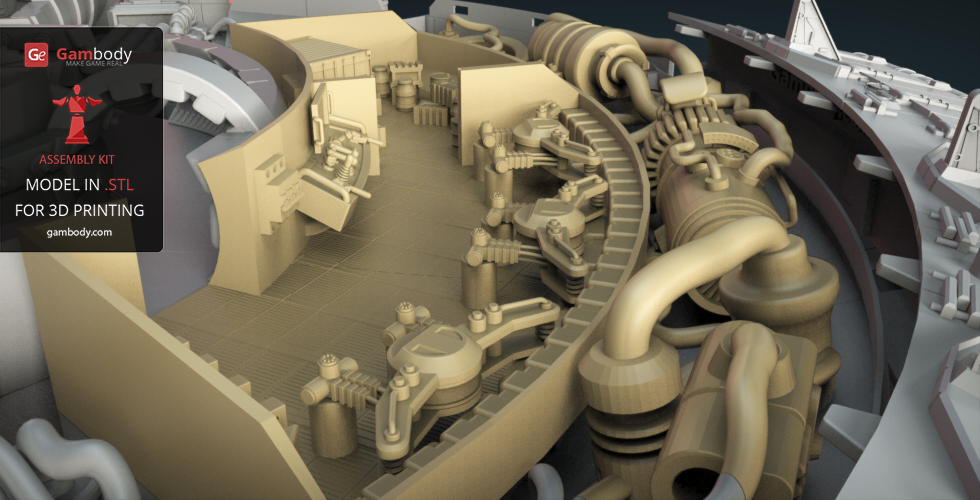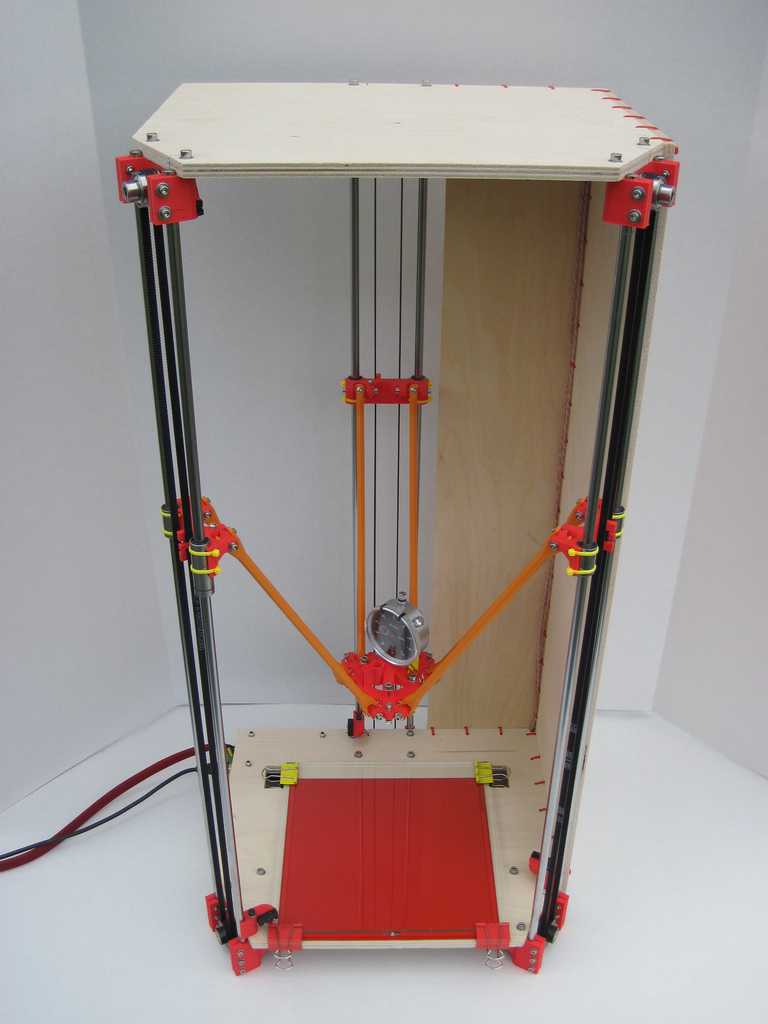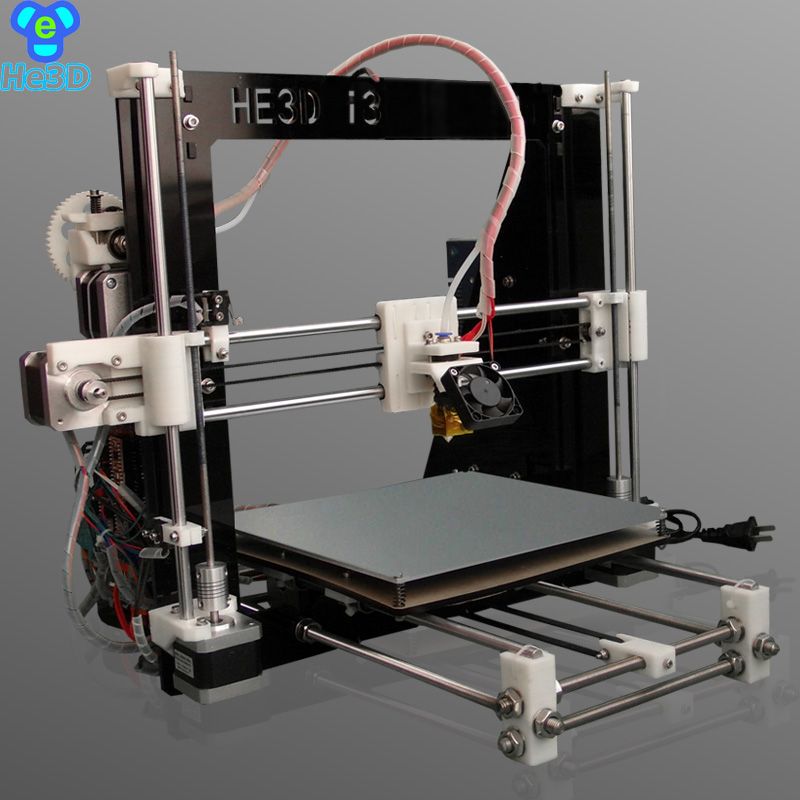Inconsistent extrusion 3d printer
Inconsistent Extrusion
Inconsistent Extrusion
For your printer to be able to create accurate parts, it needs to be capable of extruding a very consistent amount of plastic. If this extrusion varies across different parts of your print, it is going to affect the final print quality. Inconsistent extrusion can usually be identified by watching your printer closely as it prints. For example, if the printer is printing a straight line that is 20mm long, but you notice that the extrusion seems rather bumpy or seems to vary in size, then you are likely experiencing this issue. We have summarize the most common causes for inconsistent extrusion, and explained how each one can be addressed.
Common Solutions
Filament is getting stuck or tangled
The first thing you should check is the spool of plastic that is feeding into your printer. You need to make sure that this spool is able to rotate freely and that the plastic is easily being unwound from the spool. If the filament becomes tangled, or the spool has too much resistance to spin freely, it will impact how evenly the evenly the filament is extruded through the nozzle. If your printer includes a Bowden tube (a small hollow tube that the filament is routed through), you should also check to make sure that the filament can easily move through this tube without too much resistance. If there is too much resistance in the tube, you may want to try cleaning the tube or applying some lubrication inside the tube.
Clogged Extruder
If the filament is not tangled and can easily be pulled into the extruder, then the next thing to check is the nozzle itself. It is possible that there is some small debris or foreign plastic inside the nozzle that is preventing proper extrusion. An easy way to check this is to use Simplify3D’s machine control panel to manually extrude some plastic from the nozzle. Watch to make sure that the plastic is extruding evenly and consistently. If you notice problems, you may need to clean the nozzle. Please consult your manufacturer for instructions on how to properly clean the inside of the nozzle.
Please consult your manufacturer for instructions on how to properly clean the inside of the nozzle.
Very low layer height
If the filament is spinning freely and the extruder is not clogged, it may be useful to check a few settings within Simplify3D. For example, if you are trying to print at an extremely low layer height, such as 0.01mm, there is very little room for the plastic to exit the nozzle. This gap below the nozzle is only 0.01mm tall, which means that the plastic may have a difficult time exiting the extruder. Double check to make sure you are using a reasonable layer height for your printer. You can view this setting by clicking “Edit Process Settings” and selecting the Layer tab. If you are printing at a very small layer height, try increasing the value to see if the problem goes away.
Incorrect extrusion width
Another setting to check within Simplify3D is the extrusion width that you have specified for your extruder. You can find this setting by clicking “Edit Process Settings” and going to the Extruder tab.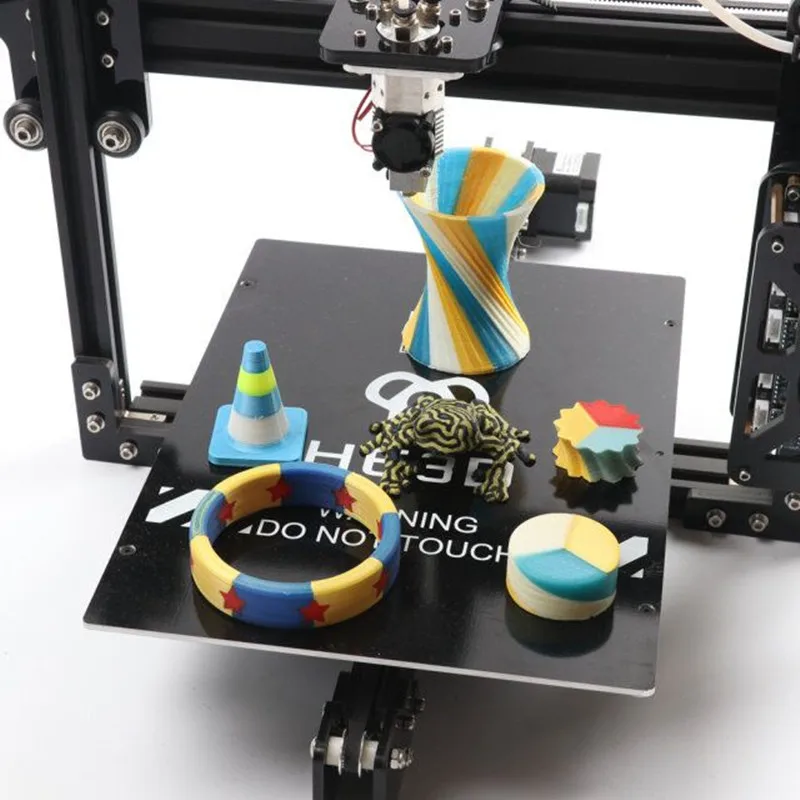 Each extruder can have its own unique extrusion width, so make sure you select the appropriate extruder from the list of the left to view the settings for that specific extruder. If you extrusion width is significantly smaller than your nozzle diameter, this may cause extrusion issues. As a general rule of thumb, the extrusion width should be within 100-150% of the nozzle diameter. If your extrusion width is far below the nozzle diameter (for example, a 0.2mm extrusion width for a 0.4mm nozzle), then your extruder won’t be able to push a consistent flow of filament.
Each extruder can have its own unique extrusion width, so make sure you select the appropriate extruder from the list of the left to view the settings for that specific extruder. If you extrusion width is significantly smaller than your nozzle diameter, this may cause extrusion issues. As a general rule of thumb, the extrusion width should be within 100-150% of the nozzle diameter. If your extrusion width is far below the nozzle diameter (for example, a 0.2mm extrusion width for a 0.4mm nozzle), then your extruder won’t be able to push a consistent flow of filament.
Poor quality filament
One of the most common causes of inconsistent extrusion that we have not mentioned yet is the quality of the filament that you are printing with. Low-quality filament may contain extra additives that impact the consistency of the plastic. Others may have an inconsistent filament diameter, which will also cause inconsistent extrusion. Finally, many plastics also have a tendency to degrade over time. For example, PLA tends to absorb moisture from the air, and over time, this will cause the print quality to degrade. This is why many spools of plastic include a desiccant in the packaging to help remove any moisture from the spool. If you think your filament may be at fault, try swapping the spool for a new, unopened, high-quality spool to see if the problem goes away.
For example, PLA tends to absorb moisture from the air, and over time, this will cause the print quality to degrade. This is why many spools of plastic include a desiccant in the packaging to help remove any moisture from the spool. If you think your filament may be at fault, try swapping the spool for a new, unopened, high-quality spool to see if the problem goes away.
Mechanical extruder issues
If you have verified everything above and are still having problems with inconsistent extrusion, then you may want to check for mechanical issues with your extruder. For example, many extruders use a drive gear with sharp teeth that bite into the filament. This allows the extruder to move the filament back and forth easily. These extruders also typically include an adjustment that changes how hard the drive gear is pressed into the filament. If this setting is too loose, the drive gear teeth won’t cut far enough into the filament, which impacts the extruder’s ability to accurately control the position of the filament.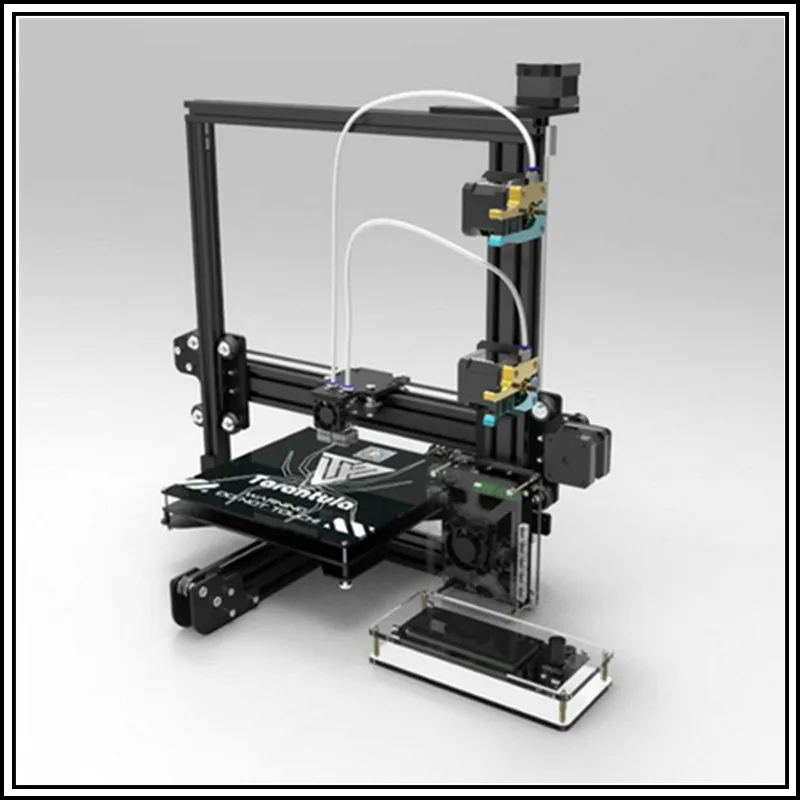 Check with your manufacturer to see if your printer has a similar adjustment.
Check with your manufacturer to see if your printer has a similar adjustment.
Related Topics
5 Ways How to Fix Inconsistent Extrusion & Lines in 3D Prints – 3D Printerly
You’ve got everything set up as usual and it’s time to get your 3D printer extruding away, which goes just fine. After some time, you notice, the print quality isn’t up to par.
This could be due to inconsistent extrusion in your 3D printer, which has many possible causes behind it.
This article will attempt to list those causes and give you a quick guide on how to fix the issue with some step-by-step solutions.
Why is My 3D Printer Giving Inconsistent Extrusion?
If you are printing something and you want it to look good and should be of high quality then perfect extrusion is essential.
If your printer does not extrude the filament consistently it will affect your design and will ruin the resulting print.
Inconsistent extrusion is a problem that can occur due to many reasons such as extruder problems, nozzle problems, or even an improper setting can cause it
It is considered as one of the many common problems that a user faces in 3D printing which is definitely fixable if you do the right things, which will be described in this article.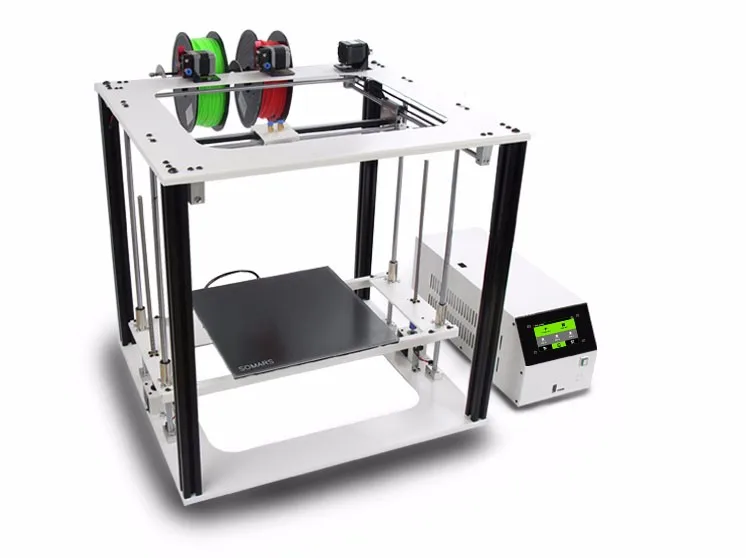
You should keep an eye on the printing process and if you notice that the print is bumpy or the size of the print layer is varying, it means that your nozzle is extruding inconsistently.
Here are the major causes behind the problem of inconsistent extrusion. Find out the actual reason that is causing the problem and then proceed forward to pick the best suitable solution.
- Printing at Low Temperature
- Nozzle is Clogged
- Short Z Distance
- PTFE Tube is Clogged or Have Resistance
- Using Bad Quality Filament
How to Fix Inconsistent Extrusion & Lines in 3D Prints
The solutions behind fixing inconsistent extrusion and lines are fairly simple so follow along to get this issue solved once and for all.
If you are experiencing inconsistent extrusion, it’s because your filament won’t extrude smoothly enough to create a high quality model.
To enjoy a perfect experience and to get the best from the 3D printer, make sure that the nozzle is extruding efficiently.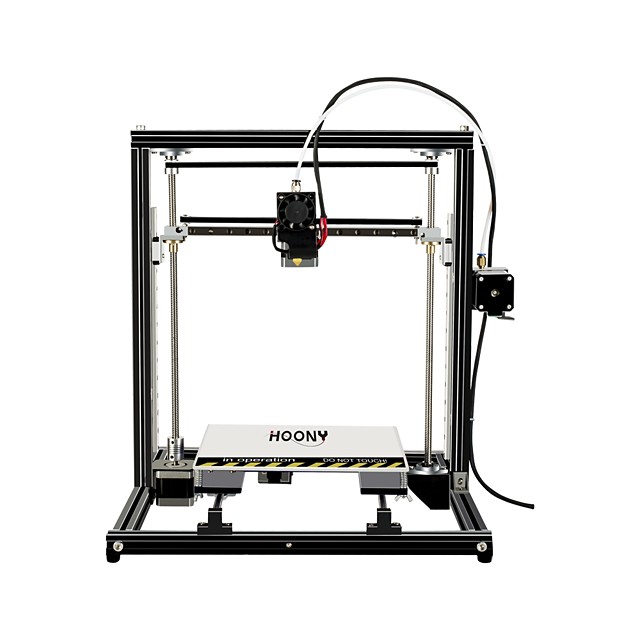
Below are the main solutions that are effective in solving problems of inconsistent extrusion.
1. Increase Your Printing Temperature
If you are facing this problem, the first thing you should try is to increase the temperature. It is possible that the filament is not getting enough heat to get melted properly.
- Increase your printing temperature and make sure that the filament is melting completely.
- Try to decrease the speed and check if any improvements occur so filament has enough time to heat up.
- Make sure that you find an optimal temperature because too much heat can also cause other problems such as oozing and stringing.
2. Make Sure the Nozzle is Not Clogged
Sometimes residue from the printing process and from burnt filament are left behind in the nozzle and get stuck. This causes the nozzle to become partially or fully clogged.
Check the filament being extruded from the nozzle during the printing process and see whether the filament is coming out straight or curled.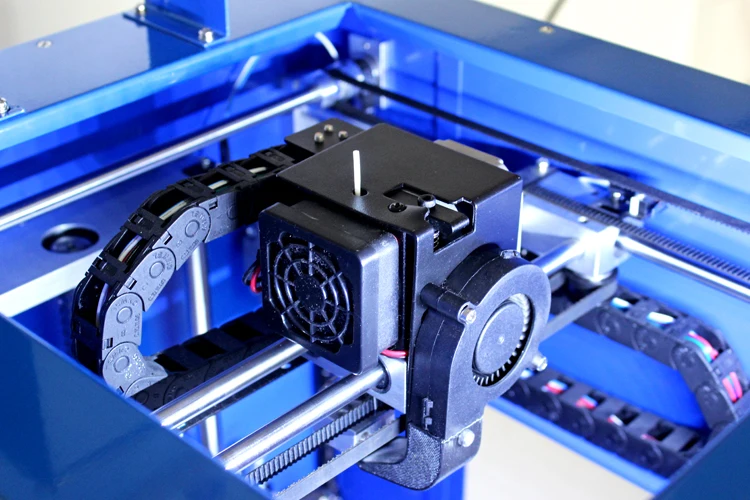
If the filament is extruding curly it means that the nozzle is probably partially clogged and if the filament is not even coming out from the nozzle, it is the indication of a fully clogged nozzle.
- Sometimes you can get rid of clogs by just increasing the printing temperature and extruding filament out
- If the clog or jam is quite stubborn, make use of a nozzle cleaning needle to push the residue out
- The best way to really clear your nozzle is to do hot and cold pulls, also called atomic pulls
- You can use cleaning filament to extrude through your nozzle which does a great job of clearing out clogs.
3. Make Sure That the Nozzle is at a Good Height
The Z distance can also be a great reason to cause inconsistent extrusion and lines in 3D prints. If the extruder is not making any noises and printing a very thin layer, it is a sure indication of improper nozzle height.
This is due to the fact that when the nozzle is too close to the print bed, the filament will not have the required space to extrude perfectly and will lead to inconsistent extrusion.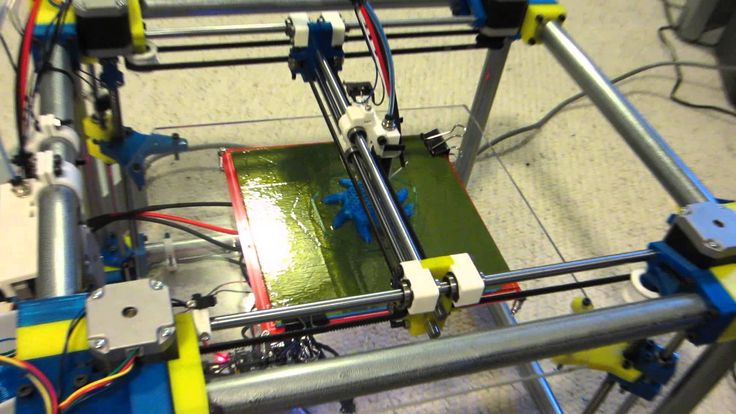
- Make sure that you are using a good layer height that is providing enough space for the filament to extrude from the nozzle.
- Increase the layer height step by step and check if any improvement occurs.
4. Check the PTFE Tube
Many people end up missing this factor out, which is checking the PTFE tube, but it can definitely be a contributing factor towards your inconsistent extrusion.
If your PTFE tube has experienced heat damage on the hotend side of things, then it can cause blockages in the extrusion pathway. The stock PTFE tube that usually comes with a 3D printer isn’t the best quality.
- Check that your tubing is fitted on properly and isn’t damaged
- Get Capricorn PTFE tubing which has a higher heat-resistance and smoother grip on filament
5. Use a Filament of High Quality
The problem might just be the quality of filament that you purchased. 3D printer filament manufacturers have been getting a lot better in their tolerances and quality control, but you can still get some pretty poorly made filament.
These low quality filament are ones that have inconsistent diameters throughout the spool of filament. When the filament is melted and extruded, there is going to be a change in flow rate which can lead to inconsistent extrusion and lines throughout the print.
Also, using bad quality filament that includes extra additives and such materials makes it difficult for the melted plastic to extrude from the nozzle without being disturbed.
If you are using an old filament then the probability of problem occurrence increases because the filament absorbs moisture from the air and loses its quality with the passage of time.
- Make sure that your filament is protected in an airtight box to prevent moisture absorption.
- Try to dry out the filament if you think that there is moisture in it which is causing the problem.
- If you are still facing the problem it is recommended to replace the old filament with a new filament of high quality which is being opened for the first time.
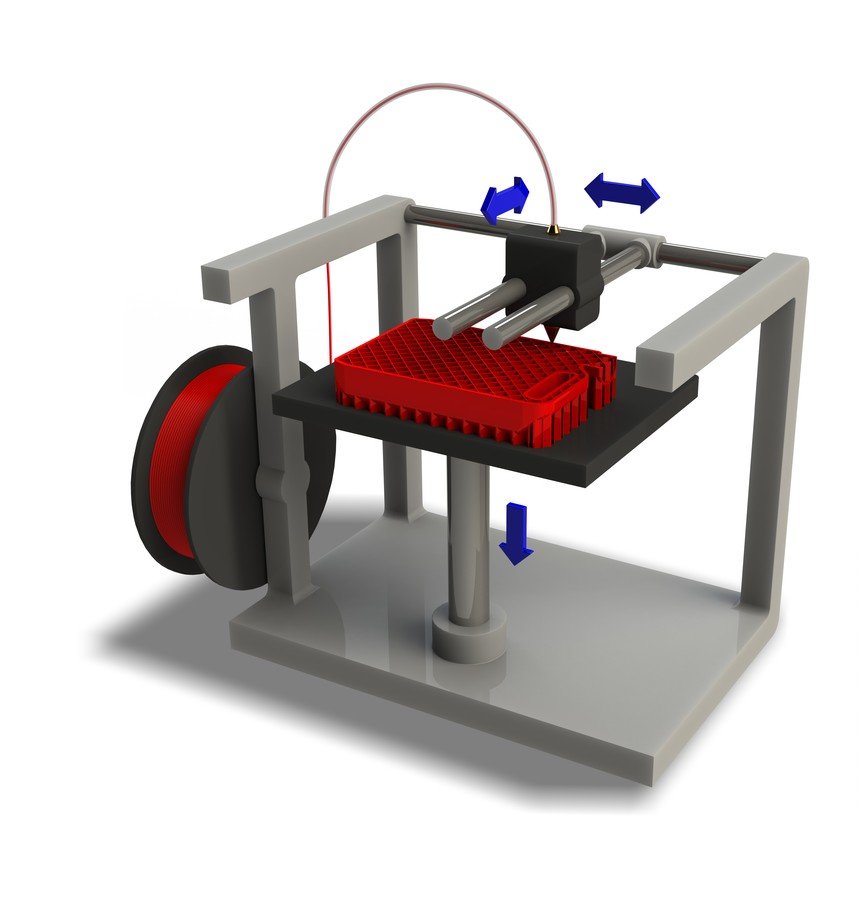
3D printing for "dummies" or "what is a 3D printer?"
- 1 3D printing term
- 2 3D printing methods
- 2.1 Extrusion printing
- 2.2 Melting, sintering or gluing
- 2.3 Stereolithography
- 2.4 Lamination
- 3 Fused Deposition Printing (FDM)
- 3.1 Consumables
- 3.2 Extruder
- 3.3 Working platform
- 3.4 Positioners
- 3.5 Control
- 3.6 Varieties of FDM printers
- 4 Laser stereolithography (SLA)
- 4.1 Lasers and projectors
- 4.2 Cuvette and resin
- 4.3 Types of stereolithographic printers
3D printing term
The term 3D printing has several synonyms, one of which quite briefly and accurately characterizes the essence of the process - "additive manufacturing", that is, production by adding material.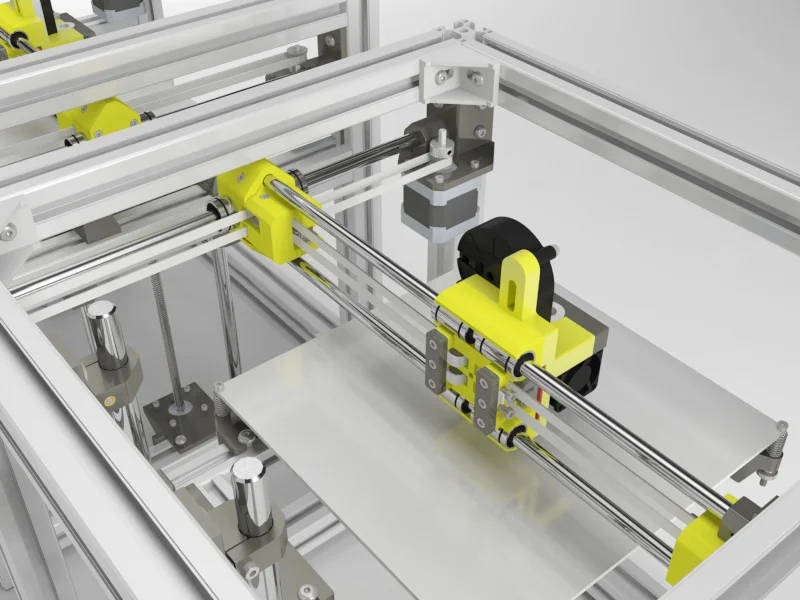 The term was not coined by chance, because this is the main difference between multiple 3D printing technologies and the usual methods of industrial production, which in turn received the name "subtractive technologies", that is, "subtractive". If during milling, grinding, cutting and other similar procedures, excess material is removed from the workpiece, then in the case of additive manufacturing, material is gradually added until a solid model is obtained.
The term was not coined by chance, because this is the main difference between multiple 3D printing technologies and the usual methods of industrial production, which in turn received the name "subtractive technologies", that is, "subtractive". If during milling, grinding, cutting and other similar procedures, excess material is removed from the workpiece, then in the case of additive manufacturing, material is gradually added until a solid model is obtained.
Soon 3D printing will even be tested on the International Space Station
Strictly speaking, many traditional methods could be classified as "additive" in the broad sense of the word - for example, casting or riveting. However, it should be borne in mind that in these cases, either the consumption of materials is required for the manufacture of specific tools used in the production of specific parts (as in the case of casting), or the whole process is reduced to joining ready-made parts (welding, riveting, etc.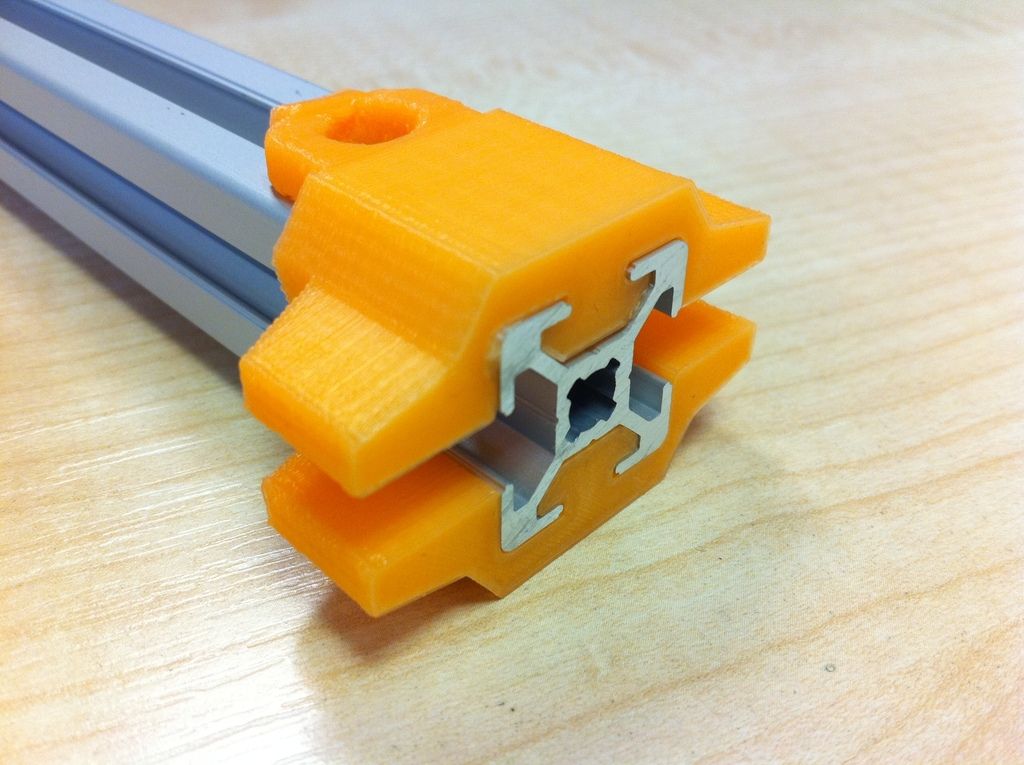 ). In order for the technology to be classified as “3D printing”, the final product must be built from raw materials, not blanks, and the formation of objects must be arbitrary - that is, without the use of forms. The latter means that additive manufacturing requires a software component. Roughly speaking, additive manufacturing requires computer control so that the shape of final products can be determined by building digital models. It was this factor that delayed the widespread adoption of 3D printing until the moment when numerical control and 3D design became widely available and highly productive.
). In order for the technology to be classified as “3D printing”, the final product must be built from raw materials, not blanks, and the formation of objects must be arbitrary - that is, without the use of forms. The latter means that additive manufacturing requires a software component. Roughly speaking, additive manufacturing requires computer control so that the shape of final products can be determined by building digital models. It was this factor that delayed the widespread adoption of 3D printing until the moment when numerical control and 3D design became widely available and highly productive.
3D printing techniques
3D printing technologies are numerous, and there are even more names for them due to patent restrictions. However, you can try to divide technologies into main areas:
Extrusion printing
This includes methods such as deposition deposition (FDM) and multi-jet printing (MJM). This method is based on the extrusion (extrusion) of consumables with the sequential formation of the finished product. As a rule, consumables consist of thermoplastics or composite materials based on them.
This method is based on the extrusion (extrusion) of consumables with the sequential formation of the finished product. As a rule, consumables consist of thermoplastics or composite materials based on them.
Melting, sintering or bonding
This approach is based on bonding powdered material together. Formation is done in different ways. The simplest is gluing, as is the case with 3D inkjet printing (3DP). Such printers deposit thin layers of powder onto the build platform, which are then selectively bonded with a binder. Powders can be made up of virtually any material that can be ground to a powder—plastic, wood, metal.
This model of James Bond's Aston Martin was successfully printed on Voxeljet's SLS printer and blown up just as successfully during the filming of Skyfall instead of the expensive original
sintering (SLS and DMLS) and smelting (SLM), which allow you to create all-metal parts. As with 3D inkjet printing, these devices apply thin layers of powder, but the material is not glued together, but sintered or melted using a laser. Laser sintering (SLS) is used to work with both plastic and metal powders, although metal pellets usually have a more fusible shell, and after printing they are additionally sintered in special ovens. DMLS is a variant of SLS installations with more powerful lasers that allow sintering metal powders directly without additives. SLM printers provide not just sintering of particles, but their complete melting, which allows you to create monolithic models that do not suffer from the relative fragility caused by the porosity of the structure. As a rule, printers for working with metal powders are equipped with vacuum working chambers, or they replace air with inert gases. Such a complication of the design is caused by the need to work with metals and alloys subject to oxidation - for example, with titanium.
Laser sintering (SLS) is used to work with both plastic and metal powders, although metal pellets usually have a more fusible shell, and after printing they are additionally sintered in special ovens. DMLS is a variant of SLS installations with more powerful lasers that allow sintering metal powders directly without additives. SLM printers provide not just sintering of particles, but their complete melting, which allows you to create monolithic models that do not suffer from the relative fragility caused by the porosity of the structure. As a rule, printers for working with metal powders are equipped with vacuum working chambers, or they replace air with inert gases. Such a complication of the design is caused by the need to work with metals and alloys subject to oxidation - for example, with titanium.
Stereolithography
How an SLA printer works
Stereolithography printers use special liquid materials called "photopolymer resins".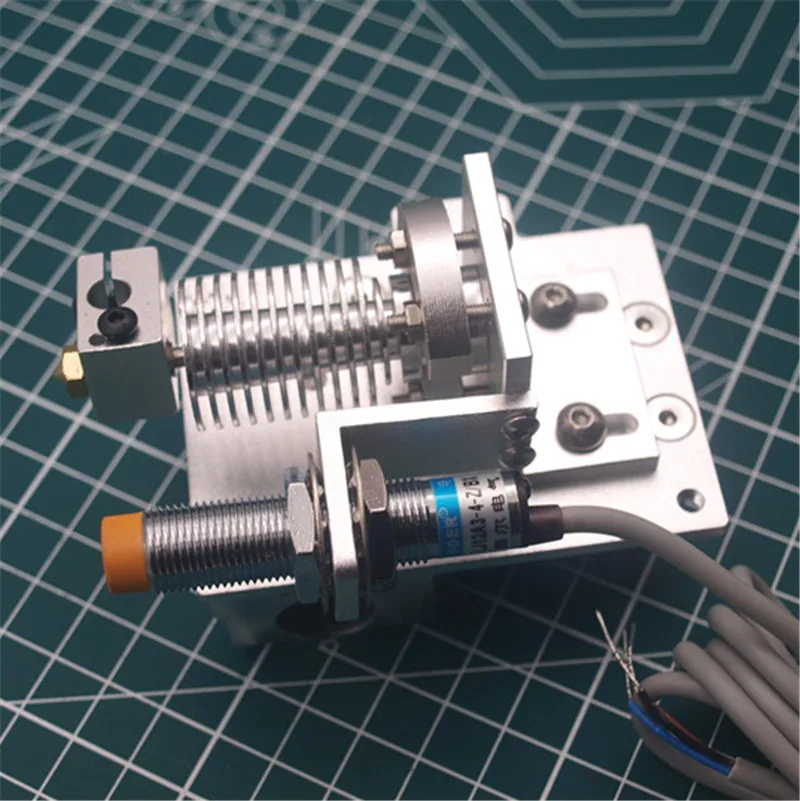 The term "photopolymerization" refers to the ability of a material to harden when exposed to light. As a rule, such materials react to ultraviolet irradiation.
The term "photopolymerization" refers to the ability of a material to harden when exposed to light. As a rule, such materials react to ultraviolet irradiation.
Resin is poured into a special container with a movable platform, which is installed in a position near the surface of the liquid. The layer of resin covering the platform corresponds to one layer of the digital model. Then a thin layer of resin is processed by a laser beam, hardening at the points of contact. At the end of illumination, the platform together with the finished layer is immersed to the thickness of the next layer, and illumination is performed again.
Lamination
Laminating (LOM) 3D printers workflow
Some 3D printers build models using sheet materials - paper, foil, plastic film.
Layers of material are glued on top of each other and cut to the contours of the digital model using a laser or a blade.
These machines are well suited for prototyping and can use very cheap consumables, including regular office paper.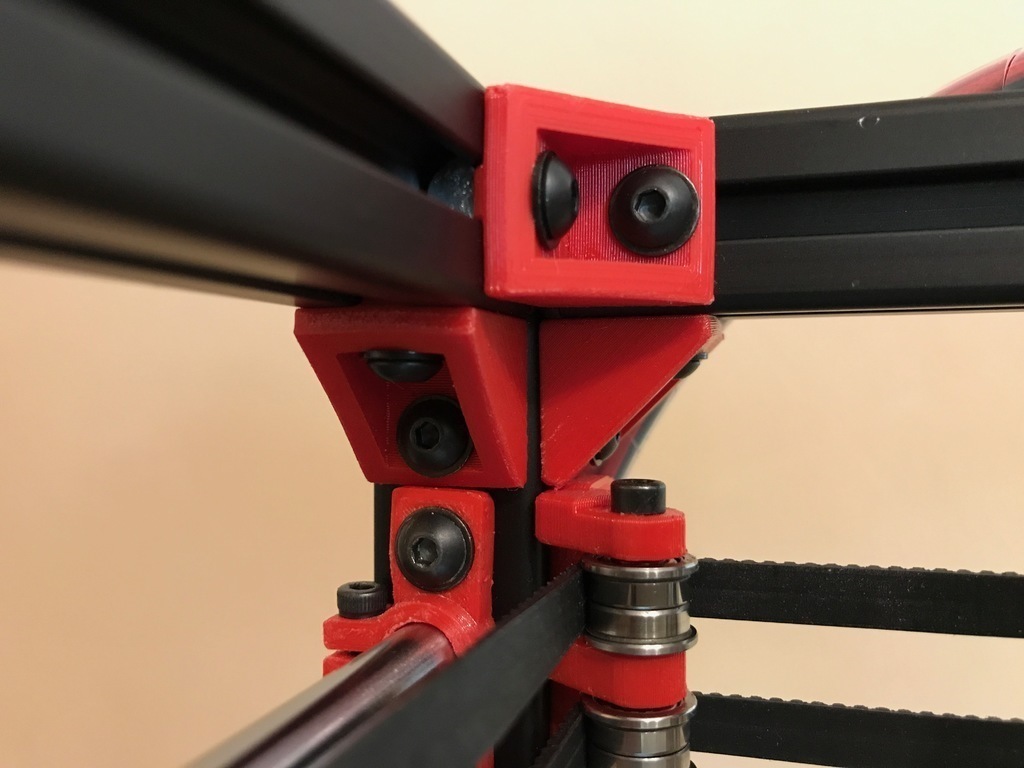 However, the complexity and noise of these printers, coupled with the limitations of the models they produce, limit their popularity.
However, the complexity and noise of these printers, coupled with the limitations of the models they produce, limit their popularity.
Fused Deposition Modeling (FDM) and Laser Stereolithography (SLA) are the most popular 3D printing methods used in the home and office.
Let's take a closer look at these technologies.
Fused Deposition Printing (FDM)
FDM is perhaps the simplest and most affordable 3D construction method, which makes it very popular.
High demand for FDM printers is driving device and consumable prices down rapidly, along with technology advances towards ease of use and improved reliability.
Consumables
ABS filament spool and finished model
FDM printers are designed to print with thermoplastics, which are usually supplied as thin filaments wound on spools. The range of "clean" plastics is very wide. One of the most popular materials is polylactide or "PLA plastic".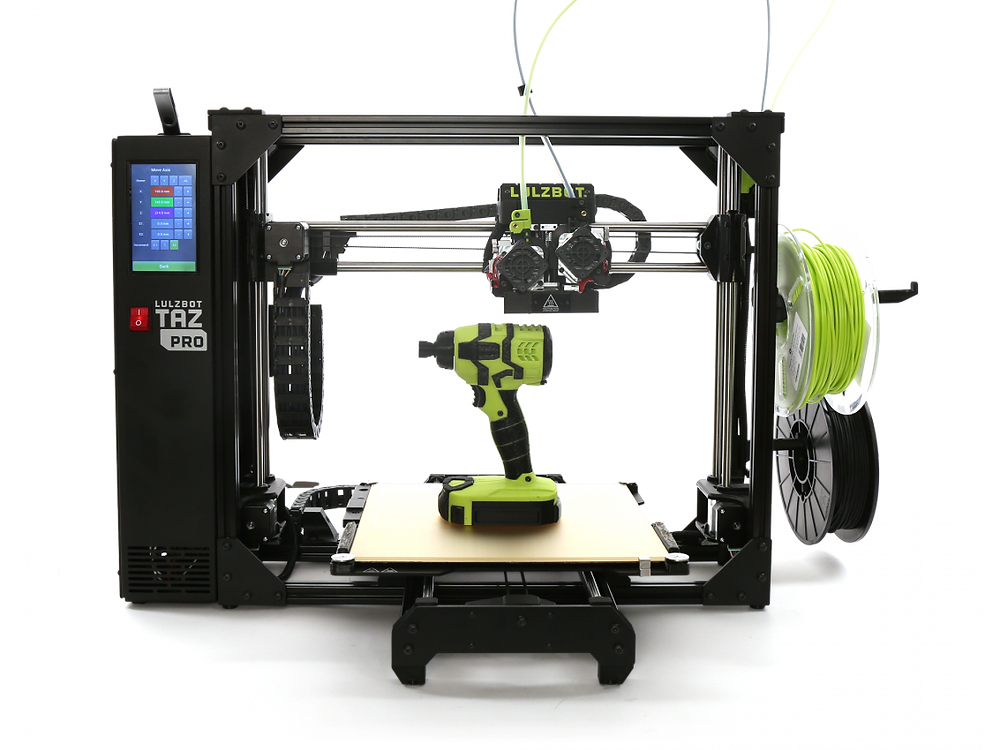 This material is made from corn or sugar cane, which makes it non-toxic and environmentally friendly, but makes it relatively short-lived. ABS plastic, on the other hand, is very durable and wear-resistant, although it is susceptible to direct sunlight and can release small amounts of harmful fumes when heated. Many plastic items that we use on a daily basis are made from this material: housings for household appliances, plumbing fixtures, plastic cards, toys, etc.
This material is made from corn or sugar cane, which makes it non-toxic and environmentally friendly, but makes it relatively short-lived. ABS plastic, on the other hand, is very durable and wear-resistant, although it is susceptible to direct sunlight and can release small amounts of harmful fumes when heated. Many plastic items that we use on a daily basis are made from this material: housings for household appliances, plumbing fixtures, plastic cards, toys, etc.
In addition to PLA and ABS, printing is possible with nylon, polycarbonate, polyethylene and many other thermoplastics that are widely used in modern industry. More exotic materials are also possible, such as polyvinyl alcohol, known as "PVA plastic". This material dissolves in water, which makes it very useful for printing complex geometric patterns. But more on that below.
Model made from Laywoo-D3. Changing the extrusion temperature allows you to achieve different shades and simulate annual rings
It is not necessary to print with homogeneous plastics. It is also possible to use composite materials imitating wood, metals, stone. Such materials use all the same thermoplastics, but with impurities of non-plastic materials.
It is also possible to use composite materials imitating wood, metals, stone. Such materials use all the same thermoplastics, but with impurities of non-plastic materials.
So, Laywoo-D3 consists partly of natural wood dust, which allows you to print "wooden" products, including furniture.
The material called BronzeFill is filled with real bronze, and models made from it can be ground and polished, achieving a high similarity to products made from pure bronze.
One has only to remember that thermoplastics serve as a binding element in composite materials - they determine the thresholds of strength, thermal stability and other physical and chemical properties of finished models.
Extruder
Extruder - FDM print head. Strictly speaking, this is not entirely true, because the head consists of several parts, of which only the feed mechanism is directly "extruder". However, by tradition, the term "extruder" is commonly used as a synonym for the entire print assembly.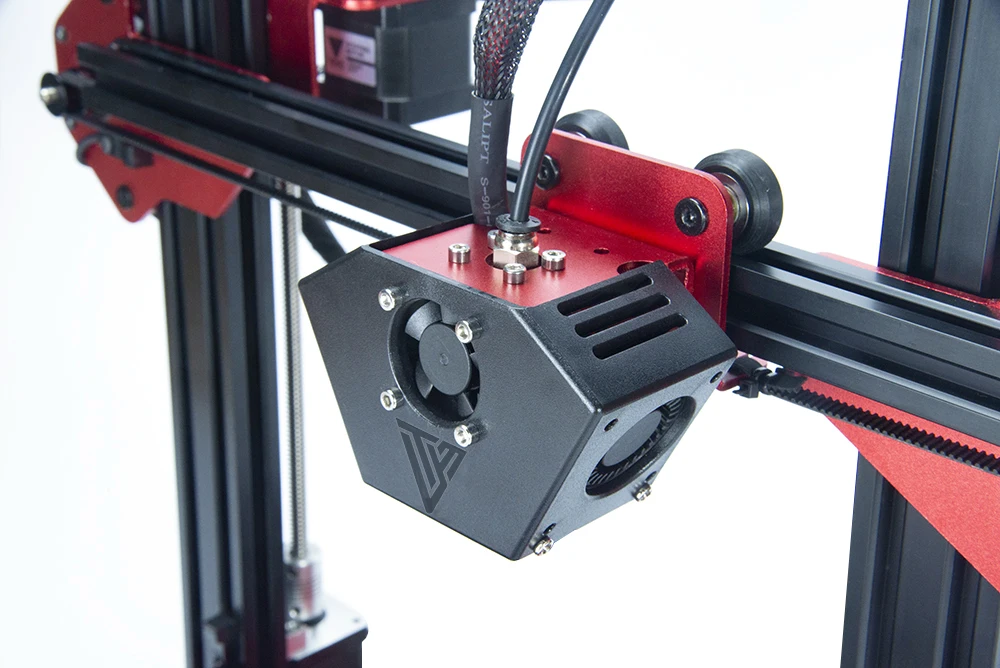
FDM extruder general design
The extruder is designed for melting and applying thermoplastic thread. The first component is the thread feed mechanism, which consists of rollers and gears driven by an electric motor. The mechanism feeds the thread into a special heated metal tube with a small diameter nozzle, called a "hot end" or simply a "nozzle". The same mechanism is used to remove the thread if a change of material is needed.
The hot end is used to heat and melt the thread fed by the puller. As a rule, nozzles are made from brass or aluminum, although more heat-resistant, but also more expensive materials can be used. For printing with the most popular plastics, a brass nozzle is quite enough. The “nozzle” itself is attached to the end of the tube with a threaded connection and can be replaced with a new one in case of wear or if a change in diameter is necessary. The nozzle diameter determines the thickness of the molten filament and, as a result, affects the print resolution.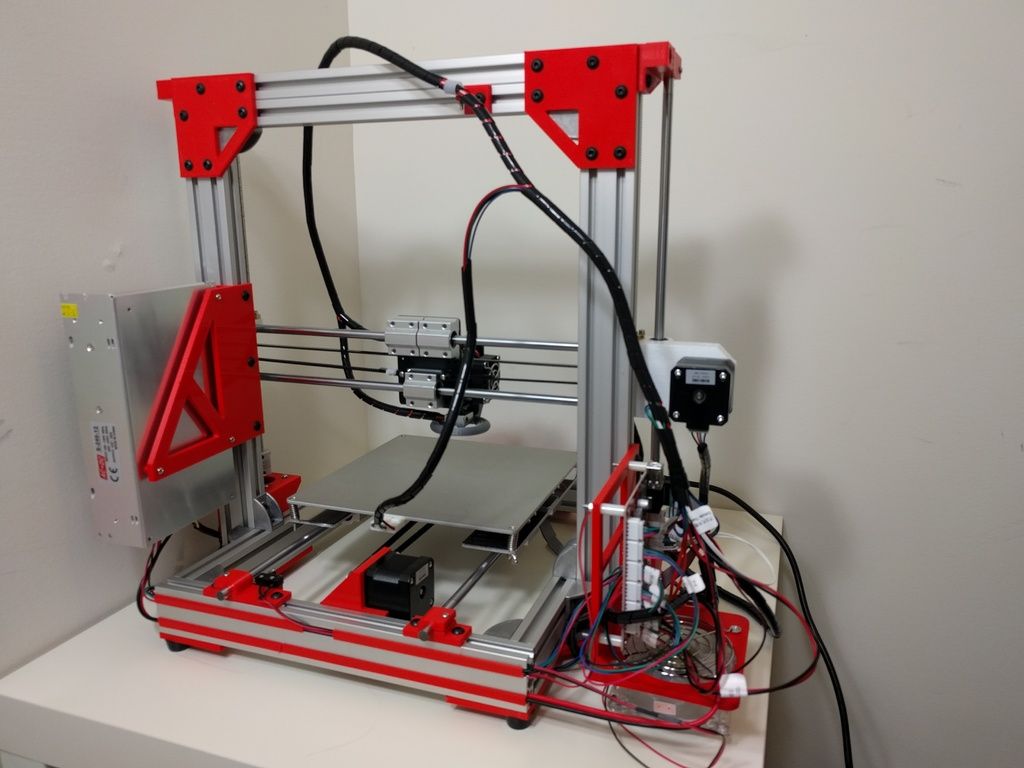 The heating of the hot end is controlled by a thermistor. Temperature control is very important, because when the material is overheated, pyrolysis can occur, that is, the decomposition of plastic, which contributes both to the loss of the properties of the material itself and to clogging of the nozzle.
The heating of the hot end is controlled by a thermistor. Temperature control is very important, because when the material is overheated, pyrolysis can occur, that is, the decomposition of plastic, which contributes both to the loss of the properties of the material itself and to clogging of the nozzle.
PrintBox3D One FDM Printer Extruder
To prevent the filament from melting too early, the top of the hot end is cooled by heatsinks and fans. This point is of great importance, since thermoplastics that pass the glass transition temperature significantly expand in volume and increase the friction of the material with the walls of the hot end. If the length of such a section is too long, the pulling mechanism may not have enough strength to push the thread.
The number of extruders may vary depending on the purpose of the 3D printer. The simplest options use a single print head. The dual extruder greatly expands the capabilities of the device, allowing you to print one model in two different colors, as well as using different materials. The last point is important when building complex models with overhanging structural elements: FDM printers cannot print “over the air”, since the applied layers require support. In the case of hinged elements, temporary support structures have to be printed, which are removed after printing is completed. The removal process is fraught with damage to the model itself and requires accuracy. In addition, if the model has a complex structure with internal cavities that are difficult to access, building conventional supports may not be practical due to the difficulty in removing excess material.
The last point is important when building complex models with overhanging structural elements: FDM printers cannot print “over the air”, since the applied layers require support. In the case of hinged elements, temporary support structures have to be printed, which are removed after printing is completed. The removal process is fraught with damage to the model itself and requires accuracy. In addition, if the model has a complex structure with internal cavities that are difficult to access, building conventional supports may not be practical due to the difficulty in removing excess material.
Finished model with PVA supports (white) before and after washing
In such cases, the same water-soluble polyvinyl alcohol (PVA) comes in handy. Using a dual extruder, you can build a model from waterproof thermoplastic using PVA to create supports.
After printing, PVA can be simply dissolved in water and a complex product of perfect quality can be obtained.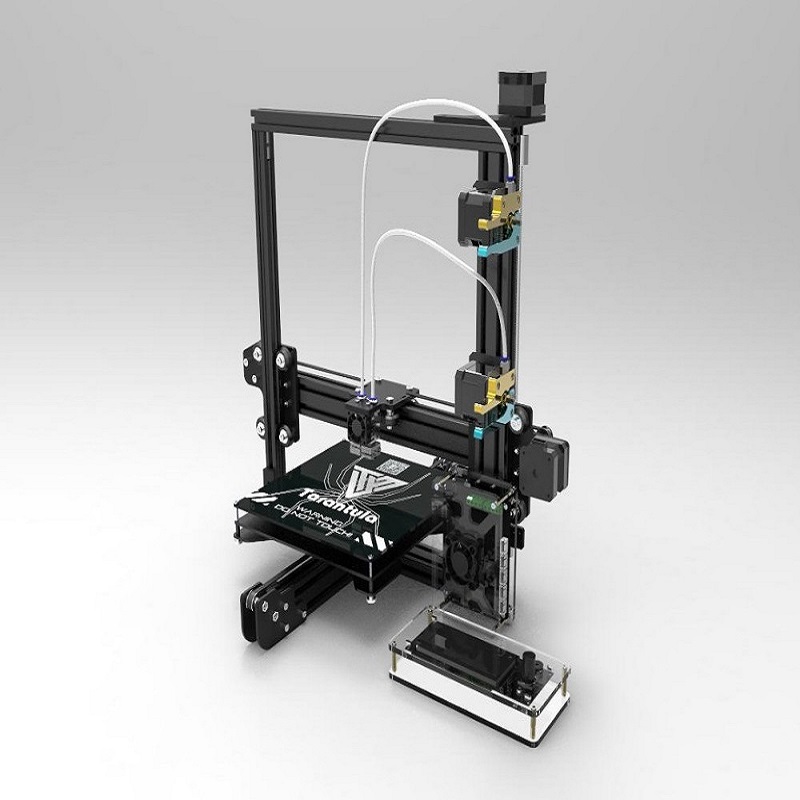
Some FDM printers can use three or even four extruders.
Working platform
Heated platform covered with removable glass work table
Models are built on a special platform, often equipped with heating elements. Preheating is required for a wide range of plastics, including the popular ABS, which are subject to a high degree of shrinkage when cooled. The rapid loss of volume by cold coats compared to freshly applied material can lead to model distortion or delamination. The heating of the platform makes it possible to significantly equalize the temperature gradient between the upper and lower layers.
Heating is not recommended for some materials. A typical example is PLA plastic, which requires a fairly long time to harden. Heating PLA can lead to deformation of the lower layers under the weight of the upper ones. When working with PLA, measures are usually taken not to heat up, but to cool the model. Such printers have characteristic open cases and additional fans blowing fresh layers of the model.
Such printers have characteristic open cases and additional fans blowing fresh layers of the model.
Calibration screw for work platform covered with blue masking tape
The platform needs to be calibrated before printing to ensure that the nozzle does not hit the applied layers and move too far causing air-to-air printing resulting in plastic vermicelli. The calibration process can be either manual or automatic. In manual mode, calibration is performed by positioning the nozzle at different points on the platform and adjusting the platform inclination using the support screws to achieve the optimal distance between the surface and the nozzle.
As a rule, platforms are equipped with an additional element - a removable table. This design simplifies the cleaning of the working surface and facilitates the removal of the finished model. Stages are made from various materials, including aluminum, acrylic, glass, etc. The choice of material for the manufacture of the stage depends on the presence of heating and consumables for which the printer is optimized.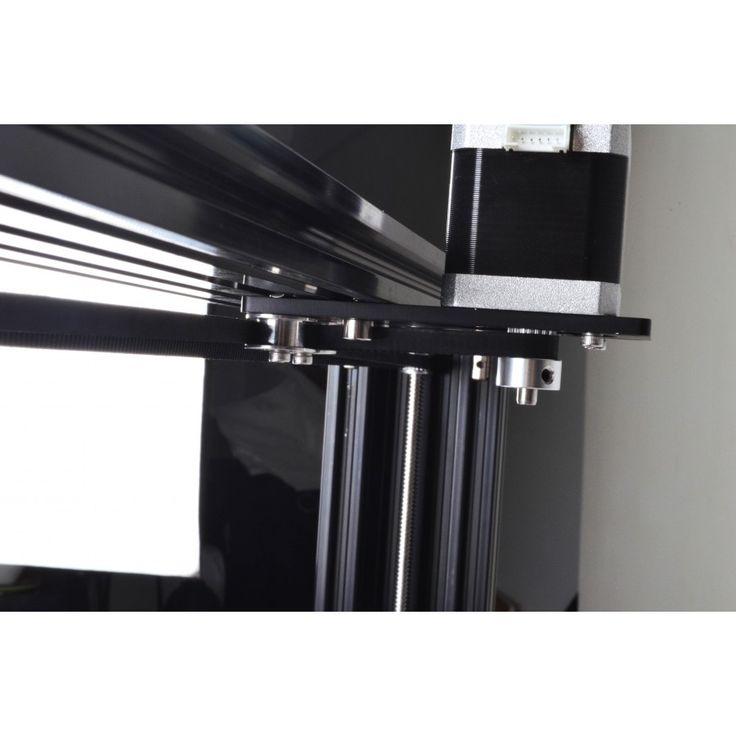
For a better adhesion of the first layer of the model to the surface of the table, additional tools are often used, including polyimide film, glue and even hairspray! But the most popular tool is inexpensive, but effective masking tape. Some manufacturers make perforated tables that hold the model well but are difficult to clean. In general, the expediency of applying additional funds to the table depends on the consumable material and the material of the table itself.
Positioning mechanisms
Scheme of operation of positioning mechanisms
Of course, the print head must move relative to the working platform, and unlike conventional office printers, positioning must be carried out not in two, but in three planes, including height adjustment.
Positioning pattern may vary. The simplest and most common option involves mounting the print head on perpendicular guides driven by stepper motors and providing positioning along the X and Y axes.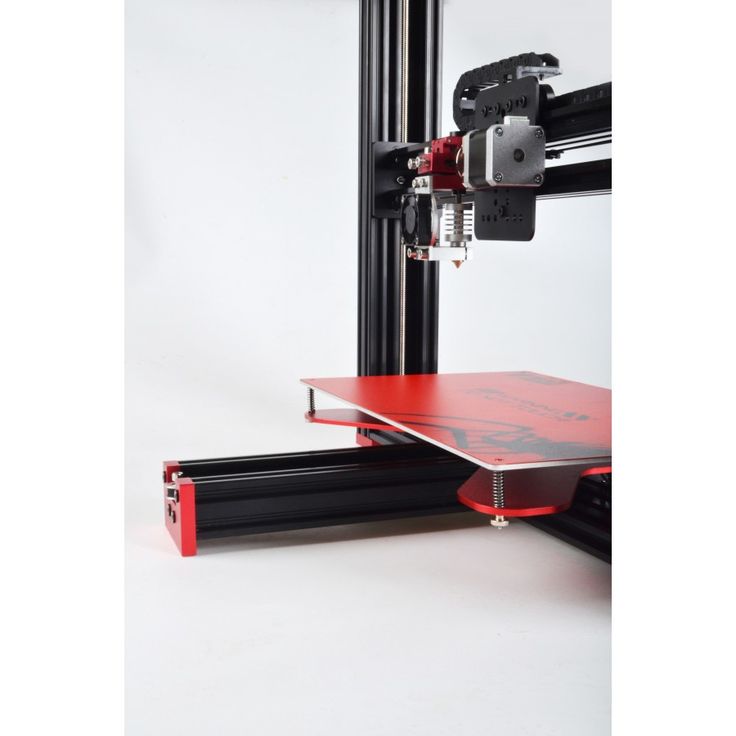
Vertical positioning is carried out by moving the working platform.
On the other hand, it is possible to move the extruder in one plane and the platforms in two.
SeemeCNC ORION Delta Printer
One option that is gaining popularity is the delta coordinate system.
Such devices are called "delta robots" in the industry.
In delta printers, the print head is suspended on three manipulators, each of which moves along a vertical rail.
The synchronous symmetrical movement of the manipulators allows you to change the height of the extruder above the platform, and the asymmetric movement causes the head to move in the horizontal plane.
A variant of this system is the reverse delta design, where the extruder is fixed to the ceiling of the working chamber, and the platform moves on three support arms.
Delta printers have a cylindrical build area, and their design makes it easy to increase the height of the working area with minimal design changes by extending the rails.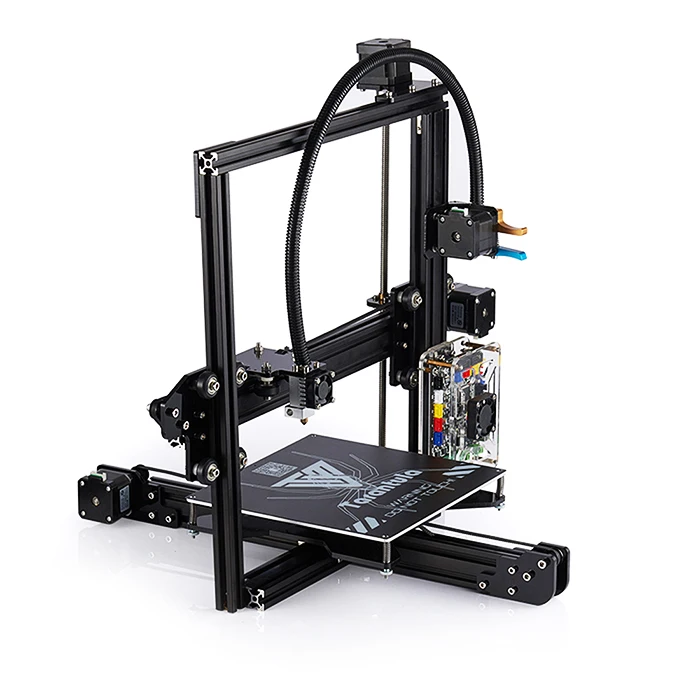
In the end, everything depends on the decision of the designers, but the fundamental principle does not change.
Control
Typical Arduino-based controller with add-on modules
The operation of the FDM printer, including nozzle and platform temperature, filament feed rate, and stepper motors for positioning the extruder, is controlled by fairly simple electronic controllers. Most controllers are based on the Arduino platform, which has an open architecture.
The programming language used by the printers is called G-code (G-Code) and consists of a list of commands executed in turn by the 3D printer systems. G-code is compiled by programs called "slicers" - standard 3D printer software that combines some of the features of graphics editors with the ability to set print options through a graphical interface. The choice of slicer depends on the printer model. RepRap printers use open source slicers such as Skeinforge, Replicator G and Repetier-Host.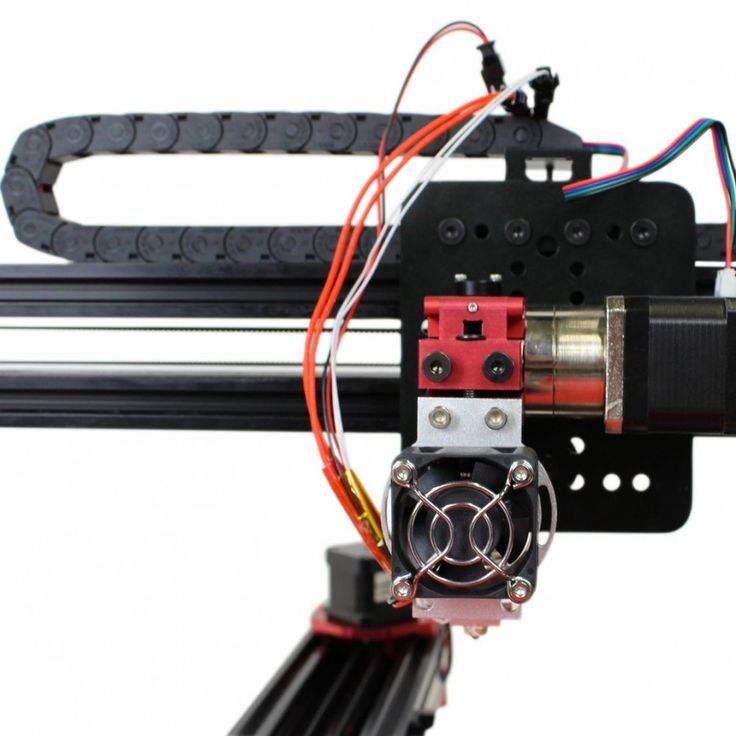 Some companies make printers that require proprietary software.
Some companies make printers that require proprietary software.
Program code for printing is generated using slicers
As an example, we can mention Cube printers from 3D Systems. There are companies that offer proprietary software but allow third-party software, as is the case with the latest generation of MakerBot 3D printers.
Slicers are not intended for 3D design per se. This task is done with CAD editors and requires some 3D design skills. Although beginners should not despair: digital models of a wide variety of designs are offered on many sites, often even for free. Finally, some companies and individuals offer 3D design services for custom printing.
Finally, 3D printers can be used in conjunction with 3D scanners to automate the process of digitizing objects. Many of these devices are designed specifically to work with 3D printers. Notable examples include the 3D Systems Sense handheld scanner and the MakerBot Digitizer handheld desktop scanner.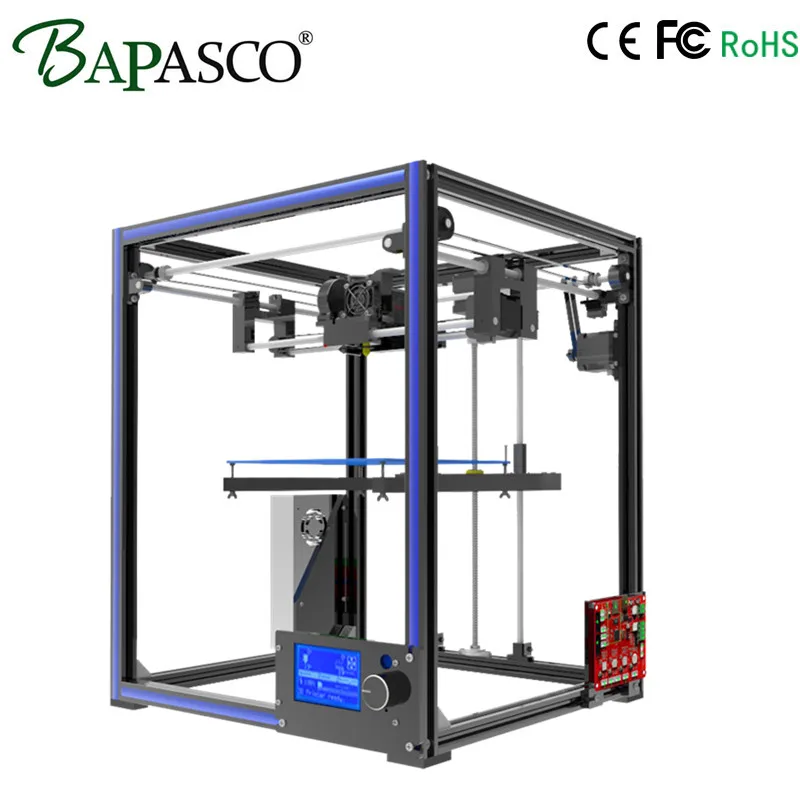
MakerBot Replicator 5th Generation FDM Printer with built-in control module on the top of the frame
The user interface of a 3D printer can consist of a simple USB port for connecting to a personal computer. In such cases, the device is actually controlled by the slicer.
The disadvantage of this simplification is a rather high probability of printing failure when the computer freezes or slows down.
A more advanced option includes an internal memory or memory card interface to make the process standalone.
These models are equipped with control modules that allow you to adjust many print parameters (such as print speed or extrusion temperature). The module may include a small LCD display or even a mini-tablet.
Varieties of FDM printers
Professional Stratasys Fortus 360mc FDM printer that allows printing with nylon
FDM printers are very, very diverse, ranging from the simplest homemade RepRap printers to industrial installations capable of printing large-sized objects.
Stratasys, founded by Scott Crump, the inventor of FDM technology, is a leader in the production of industrial installations.
You can build the simplest FDM printers yourself. Such devices are called RepRap, where "Rep" indicates the possibility of "replication", that is, self-reproduction.
RepRap printers can be used to print custom built plastic parts.
Controller, rails, belts, motors and other components can be easily purchased separately.
Of course, assembling such a device on your own requires serious technical and even engineering skills.
Some manufacturers make it easy by selling DIY kits, but these kits still require a good understanding of the technology. RepRap Printers
And, despite their "homemade nature", RepRap printers are quite capable of producing models with quality at the level of expensive branded counterparts.
Ordinary users who do not want to delve into the intricacies of the process, but require only a convenient device for household use, can purchase a ready-made FDM printer.
Many companies are focusing on the development of the consumer market segment, offering 3D printers for sale that are ready to print “right out of the box” and do not require serious computer skills.
3D Systems Cube consumer 3D printer
The most famous example of a consumer 3D printer is the 3D Systems Cube.
While it doesn't boast a huge build area, ultra-fast print speeds, or superb build quality, it's easy to use, affordable, and safe: This printer has received the necessary certification to be used even by children.
Mankati FDM printer demonstration: http://youtu.be/51rypJIK4y0
Laser Stereolithography (SLA)
Stereolithographic 3D printers are widely used in dental prosthetics
Stereolithographic printers are the second most popular and widespread after FDM printers.
These units deliver exceptional print quality.
The resolution of some SLA printers is measured in a matter of microns - it is not surprising that these devices quickly won the love of jewelers and dentists.
The software side of laser stereolithography is almost identical to FDM printing, so we will not repeat ourselves and will only touch on the distinctive features of the technology.
Lasers and projectors
Projector illumination of a photopolymer model using Kudo3D Titan DLP printer as an example
The cost of stereolithography printers is rapidly declining due to growing competition due to high demand and the use of new technologies that reduce the cost of construction.
Although the technology is generically referred to as "laser" stereolithography, most recent developments use UV LED projectors for the most part.
Projectors are cheaper and more reliable than lasers, do not require the use of delicate mirrors to deflect the laser beam, and have higher performance. The latter is explained by the fact that the contour of the whole layer is illuminated as a whole, and not sequentially, point by point, as is the case with laser options. This variant of the technology is called projection stereolithography, "DLP-SLA" or simply "DLP". However, both options are currently common - both laser and projector versions.
Cuvette and resin
Photopolymer resin is poured into a cuvette
A photopolymer resin that looks like epoxy is used as consumables for stereolithographic printers. Resins can have a variety of characteristics, but they all share one key feature for 3D printing applications: these materials harden when exposed to ultraviolet light. Hence, in fact, the name "photopolymer".
When polymerized, resins can have a wide variety of physical characteristics. Some resins are like rubber, others are hard plastics like ABS. You can choose different colors and degrees of transparency. The main disadvantage of resins and SLA printing in general is the cost of consumables, which significantly exceeds the cost of thermoplastics.
On the other hand, stereolithography printers are mainly used by jewelers and dentists who do not need to build large parts but appreciate the savings from fast and accurate prototyping. Thus, SLA printers and consumables pay for themselves very quickly.
Example of a model printed on a laser stereolithographic 3D printer
Resin is poured into a cuvette, which can be equipped with a lowering platform. In this case, the printer uses a leveling device to flatten the thin layer of resin covering the platform just prior to irradiation. As the model is being made, the platform, together with the finished layers, is “embedded” in the resin. Upon completion of printing, the model is removed from the cuvette, treated with a special solution to remove liquid resin residues and placed in an ultraviolet oven, where the final illumination of the model is performed.
Some SLA and DLP printers work in an "inverted" scheme: the model is not immersed in the consumable, but "pulled" out of it, while the laser or projector is placed under the cuvette, and not above it. This approach eliminates the need to level the surface after each exposure, but requires the use of a cuvette made of a material transparent to ultraviolet light, such as quartz glass.
The accuracy of stereolithographic printers is extremely high. For comparison, the standard for vertical resolution for FDM printers is considered to be 100 microns, and some variants of SLA printers allow you to apply layers as thin as 15 microns. But this is not the limit. The problem, rather, is not so much in the accuracy of lasers, but in the speed of the process: the higher the resolution, the lower the print speed. The use of digital projectors allows you to significantly speed up the process, because each layer is illuminated entirely. As a result, some DLP printer manufacturers claim to be able to print with a vertical resolution of one micron!
Video from CES 2013 showing Formlabs Form1 stereolithography 3D printer in action: http://youtu.be/IjaUasw64VE
Stereolithography Printer Options
Formlabs Form1 Desktop Stereolithography Printer
As with FDM printers, SLA printers come in a wide range in terms of size, features and cost. Professional installations can cost tens if not hundreds of thousands of dollars and weigh a couple of tons, but the rapid development of desktop SLA and DLP printers is gradually reducing the cost of equipment without compromising print quality.
Models such as the Titan 1 promise to make stereolithographic 3D printing affordable for small businesses and even home use at around $1,000. Formlabs' Form 1 is available now for a factory selling price of $3,299.
The developer of the DLP printer Peachy generally intends to overcome the lower price barrier of $100.
At the same time, the cost of photopolymer resins remains quite high, although the average price has fallen from $150 to $50 per liter over the past couple of years.
Of course, the growing demand for stereolithographic printers will stimulate the growth in the production of consumables, which will lead to further price reductions.
Go to the main page of the Encyclopedia of 3D printing
how it works, a review of culinary (confectionery) models and examples of work for cakes and chocolate printing products.
How it works and types of devices
The principle of operation of a 3D food printer is similar to that of a conventional inkjet printer. The only difference is that instead of simple ink cartridges in a food 3D printer, food coloring cartridges are used. The memory of the device allows you to store many recipes. To print the desired dish, you just need to select the saved recipe and press the button. After the dish is sent to print, the printer will begin to lay out the ingredients in layers on the work surface or directly on the plate. The printed dish can be sent to cool in the refrigerator or baked in the oven.
Views
Despite the fact that 3D food printing technology is the youngest in the field of 3D modeling, it is dynamically developing and improving in several directions at once. Food 3D printers have significant differences and are divided into several types:
- Food extrusion type 3D printer - this type of device extrudes the edible mass layer by layer onto the work surface until the dish is completely formed. The operation of the printer is controlled by a computer, on which the three-dimensional model of the object and the recipe are located. The printer itself, like its inkjet counterparts, is very simple - it consists of a table and a print head. The head moves along three coordinate axes, and an extruder is placed inside it to heat the mixture. The extruder is the main element of extrusion type printers. The printing ingredients are filled into a special syringe, which is placed in the print head.
A significant disadvantage of this type of device is that the more complex the model in terms of composition and color scheme, the more often you will have to stop printing and replace the syringe. Extrusion-type printers include Chokola 3D - the device allows you to work with chocolate and pasty ingredients.
Please note! The smaller the diameter of the nozzle through which the raw material is squeezed out, the neater, more accurate and more realistic the printed dish will be.
- 3D food carousel printer - despite the fact that the main working element of this type of printer is an extruder, such devices are called carousel because of the feed mechanism. The carousel 3D printer rotates over the working surface of the container with raw materials, selecting the desired ingredient and squeezing out the dosage of the product indicated in the recipe. Outwardly, the printer really resembles a kind of carousel - containers with products rotate at a slow pace over the table.
An almost unlimited number of recipes can be stored in the base of a carousel-type food 3D printer, and special skills are not needed to use it. All that is required from the user is to simply press a button and start printing. The carousel printer independently dispenses raw materials, alternately squeezing out the food mixture from the desired container. Depending on the model of the device, the containers can be from 4 to 16 pieces. Author's product from Martha Stewarts Crafts - the Cricut Cake carousel printer will help you create an original cookie or decoration for a festive cake. The owner of the printer just needs to press the start button - everything else will be done by Cricut Cake. Included with the device is a large cookbook with ideas for creating real edible works of art.
What can be done with a 3D food printer?
A wide range of 3D-compatible ingredients make it possible to create virtually any 3D model - the scale is limited only by the user's imagination. With the help of a food 3D printer, you can create figures of any complexity that will give even a simple cake a designer look.
Three-dimensional models of the bride and groom or any hero of the occasion; mask-cast of chocolate; planes, cars and cartoon characters on cakes for children; voluminous bouquets; edible figurines; original inscriptions and company logos - all this can be printed on a food 3D printer.
That is why such devices are gaining more and more popularity in hand-made confectioneries - exclusive products attract customers and emphasize the professionalism of the creator.
Printing pancakes
If you are not impressed by unusual cake decorations and original edible models, and you think that 3D food printing is just pampering, then especially for you and other connoisseurs of a rational approach, manufacturers have released 3D printers that bake pancakes. The device is a dream of housewives and pancake lovers, it costs more than a pancake maker or an ordinary frying pan, but can even the most modern pancake maker bake pancakes in the shape of a dinosaur, your favorite character or even your own head for breakfast?
As an example, consider the PancakeBot model, which not only bakes pancakes and pancakes, but also knows how to create shadows and halftones. Thanks to these unique features, 3D images printed on the PancakeBot are as realistic and voluminous as possible. During the printing process, the printer immediately fries the products.
The PancakeBot uses a heated non-stick surface as its working base and computer controlled heat and extruder action. The model is equipped with one print head, connects to a computer via an SD card or USB cable. The productivity of the printer is 100mm/s.
Like any device, PancakeBot and other 3D food printers have their advantages and disadvantages.
The main drawback of the design of printers that print pancakes, users consider the inadmissibility of even the slightest lumps in the dough. The fact is that even the smallest lump can clog the nozzles of the device and stall the printing process. The problem is solved simply - just monitor the viscosity of the dough.
The advantages of PancakeBot are highly appreciated by artists and creative personalities - the user can draw absolutely everything that his talent and flight of fancy allow him to draw.
Indisputable plus - simple ingredients. PancakeBot does not require expensive raw materials - the printer works with a simple pancake dough, the taste of which depends only on the user.
Please note! The manufacturer's website notes that any image can be downloaded to the PancakeBot's SD card, be it images downloaded from the Internet or your own photos.
Another benefit of PancakeBot is its availability. The device is relatively inexpensive.
PancakeBot will suit both private mini-confectioneries and catering chains, as well as simple pancake lovers — unusual pancakes and pancakes will delight children, decorate any holiday and surprise customers.
Sugar printing
Back in 2013, architects Kyle and Liz von Hasseln founded The Sugar Lab and, to the delight of sweet lovers, found a new application for 3D inkjet printing. Using the ChefJet confectionery food 3D printer as an example, we will talk about the production of three-dimensional models from sugar.
ChefJet applies a thin layer of granulated candy to the work surface and then selectively glues it with water, which is fed through the nozzle of the print head. The ChefJet head follows the contours of a digital model, moving in two dimensions. The printer then applies a new layer of ingredients, repeating the process to form the next layer of the shape.
Food additives and dyes make it possible to create models of different flavors and colors.
The ChefJet is a little too big for a typical kitchen, but the size of the working area inspires respect and allows you to decorate the average birthday cake.
Even the most inexpensive version of ChefJet has a significant plus - the printer can print mint, vanilla, chocolate, cherry and apple candies and icing. The disadvantage of the basic configuration is the inability to print multi-color sweets.
A more advanced version of the ChefJet allows you to print different colors of candy and mix flavors. Only one comparative disadvantage overshadows the professional model - the dimensions of the device have increased somewhat.
Perhaps the main advantage of ChefJet is the ability of the printer to work not only on powdered sugar, but also on caramel and even on chocolate chips.
The use of additive manufacturing allows ChefJet to create highly geometrically accurate sugar models.
Please note! ChefJet can even print hollow sugar products with free-flowing fillings in any flavor. For example, it is quite possible to print an edible rattle - ChefJet accurately prints edges, avoiding sharp corners and unsafe chips.
The ChefJet 3D Food Printer is designed for professional chefs and confectioners who will operate printers in bakeries, pastry shops and restaurants. Especially for users, the manufacturer plans to complete the devices with software and a digital cookbook. As an example, the manufacturer cites the possibility of printing figurines for wedding cakes.
Perhaps the high cost of ChefJet is the main disadvantage of this printer. However, there is always an opportunity to save money - on the market you can find used devices in good condition at a lower price.
Chocolate printing
Choc Creator 2.0 Plus is the best example of a chocolate printing 3D food printer. In our opinion, this is one of the most stable working models, affordable and creating real miracles from chocolate.
Choc Creator 2.0 Plus is the perfect assistant for chocolatiers, professional confectioners and just lovers of real Belgian chocolate.
Choc Creator 2.0 Plus was developed taking into account all the disadvantages of the previous version - the creators improved the convenience and technology of work, but did not forget about the design of the device - the new Choc Creator conquers with its compact dimensions, high performance, intuitive interface and unlimited possibilities for working with chocolate .
A few words about the design - the printer is equipped with a 5-inch touch screen. The start and settings buttons are conveniently located on the screen.
Choc Creator 2.0 Plus will fit both in a professional pastry chef's kitchen and in an apartment - the printer can easily be placed on a bar counter, windowsill and any other flat surface.
Another indisputable plus for visuals is the opportunity to observe the process of printing figures from chocolate.
Choc Creator 2.0 Plus is a master of chocolate, from miniature cake decorating figures to large chocolate models.
The concern of the manufacturer for its customers deserves special attention, which is felt from the moment you open the box with the printer. First, Choc Creator 2.0 Plus is in assembled condition. Secondly, a small transparent suitcase, complete with the necessary accessories, emphasizes the premium model. Inside the case are:
- stainless steel syringe;
- two nozzles of different diameters;
- special needle for cleaning clogged nozzles;
- magnets for easy paper fixing;
- 5 loading heads;
- Stylish USB flash drive in gold casing;
- height calibration disc;
- hex.
The manufacturer has not forgotten about the brush for cleaning the syringe, the stylus for the touchscreen and other useful little things that express concern for the buyer. It would seem that Choc Creator 2.0 Plus is one solid plus, but there is also a relatively small drawback - the printer only works on high-quality raw materials without additives.
The creators of the printer strongly recommend using only Belgian chocolate with a cocoa content of at least 54.5%.
Choc Creator 2.0 Plus will suit both professional chocolatiers and confectioners, as well as simple connoisseurs of quality chocolate.
3D printing on drinks
Just a few years ago, only a few baristas could draw a simple pattern on coffee. The process took time, and the result did not always meet the client's expectations. Serious competition for the creative workers of coffee houses and their flowers on the foam was 3D printers. These devices can print anything on any drink, including milkshakes and beer.
CafeMaker is a 3D inkjet printer that can print images on various types of drinks, and can do it with three food colors at the same time. CafeMaker's print speed is 10 seconds/cup, allowing you to design your drinks in seconds.
Important! The CafeMaker doesn't just print on drinks, it can also print on small cream cakes.
An indisputable plus of CafeMaker is its own CupShow application, in which you can select pictures for printing from those saved in the device's memory, as well as create inscriptions, logos, or even print personal photos.
CafeMaker can print in one color or in a set of cyan, red and yellow.
The process of refilling the CafeMaker is similar to working with a conventional inkjet printer - dye is slowly poured into the cartridge, and then the finished cartridges are placed inside the device.
A small drawback of the device lies in its requirements for a cup or glass - containers should not be transparent, their height should not exceed 18 cm, and their diameter should not exceed 11 cm. restaurant - any client will be happy to receive a cup of coffee, a glass of beer or a cupcake with an original image.
Printing with paste ingredients
Printing with sugar and chocolate is no longer just a fantasy. Now you will not surprise anyone with three-dimensional models from familiar products, so 3D printer manufacturers decided to take a step towards lovers of everything unusual and create devices that print almost any product from various ingredients.
The Foodini 3D printer will give a confident rebuff to multicookers and other kitchen gadgets - the device can print dumplings on its own, prepares the finest Italian pasta, cookies, donuts covered with icing, and even hamburgers.
Up to five different textures can be loaded into the Foodini printer at the same time. Thanks to the nozzles of different diameters, which are supplied with the printer, a wide variety of dishes are suitable for printing.
Unlike its counterparts, Foodini has firmly taken its place in the restaurant business. Of course, not all establishments can afford an expensive unit. For example, the Foodini printer is used in one of the most popular restaurants in Barcelona, La Enoteca. One of the institution's most unusual dishes is seafood puree, which is almost impossible to decorate by hand so gracefully.
The print speed of the Foodini printer is 100 mm/s, which is another advantage of the device.
Perhaps the only relative disadvantage of Foodini is its high price, but it is compensated by the increased interest of customers in the dishes produced and, as a result, an increase in the institution's profit. The Foodini printer is ideal for restaurants and other catering establishments that want to emphasize the creative approach of the management and the chef, as well as the high class of the company.
What raw materials are used for printing?
The following ingredients can be used as raw materials for 3D edible printing:
- plain chocolate and chocolate chips;
- food mastic;
- sugar;
- curd mass;
- fish, meat and liver pates;
- cheese;
- fruit and vegetable spreads;
- flour;
- food colors and flavors.
Learn more







